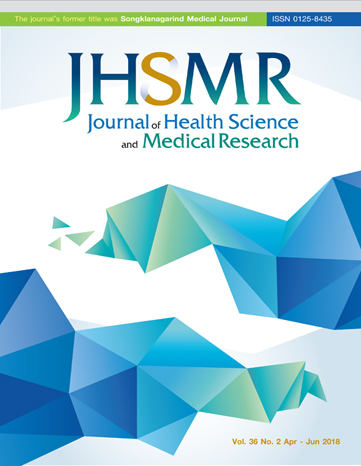Validation of an Awareness and Preparedness on a Hearing Conservation Program Questionnaire: A Cross Sectional Study in Thailand
DOI:
https://doi.org/10.31584/jhsmr.2018.36.2.6Keywords:
awareness, hearing conservation, noise-induced hearing loss, preparednessAbstract
Objective: To validate a hearing conservation program (HCP) questionnaire based on the health belief model and stages
of change model (or transtheoretical model).
Material and Methods: The perception levels of 145 workers who voluntarily participated at 2 companies were determined using this HCP questionnaire from April 2014 to September 2015. Exploratory factor analysis was performed to justify the final questionnaire.
Results: The final questionnaire had 24 items with 5 components: risk acceptance (8 items), perceived barriers (3 items), perceived benefits (5 items), role model (4 items), and the stages of change (4 items). Cronbach’s alpha coefficients of each component were 0.75, 0.64, 0.84, 0.85, 0.71, and the total Cronbach’s alpha coefficient of this questionnaire was 0.78. Workers in the factory who promoted continuous safety activities of HCP had a better score in all dimensions than those workers in the factory who did not.
Conclusion: This questionnaire of 5 components was a well validated, predictable, and positive instrument for the HCP situation in manufacturing.
References
2. Ministry of Labor, Thailand. Rules and procedures for preparation of a hearing conservation program in the workplace. Royal Gazette, 20 May B.E. 2553.
3. Miyakita T, Ueda A. Estimates of worker with noise-induced hearing loss and population at risk. J Sound Vib 1997;205:441-9.
4. Musiba Z. The prevalence of noise-induced hearing loss among Tanzanian miners. Occup Med 2015. Doi: 10.1093/occmed/kqv046.
5. Nandi SS, Dhatrak SV. Occupational noise-induced hearing loss in India. Indian J Occup Environ Med 2008;12:53-6.
6. Osibogun A, Igweza IA, Adeniran LO. Noise-induced hearing loss among textile workers in Lagos metropolis. Niger Postdrad Med J 2000;7:104-11.
7. Tantranont K, Srisuphan W, Kaewthummanukul T, Suthakorn W, Jormsri P, Salazar M. Factors affecting Thai workers’ use of hearing protection. AAOHN 2009;57:455-63.
8. Pholchan T, Peeravud S, Chayarpham S, Tuntiseranee P. Noiseinduced hearing loss and its determinants among workers in food supply, central supply and maintenance departments at Songklanagarind Hospital. Songkla Med J 2004;22:27-36.
9. Pethprapan R, Khaimook W, Choosong T. Evaluation of noise levels and noise-induced hearing loss of workers at stone milling factory. J Safety Health 2004;8:13-23.
10. Khaimook W, Suksamae P, Choosong T, Chayarpham S, Tantisarasart R. The prevalence of niose-induced occupational hearing loss in dentistry personnel. Workplace Health Saf 2014;62:357-60.
11. Berry C. A guide to developing and maintaining an effective hearing conservation program. Washington: Occupational Safety and Health Division; 2012.
12. Rosenstock IM, Strecher VJ, Becker MH. Social learning theory and health belief model. Health Educ Q 1988;15:175-83.
13. McKenzie JF, Neiger BL, Thackeray R. Planning, implementing, and evaluating health promotion programs: a primer. 5th ed. California: Pearson Benjamin Cummings; 2009.
14. Jitjamnong A. An awareness and readiness to hearing conservation program in industrial technical department of vocational collage, Songkhla Province [Dissertation]. Songkhla: Prince of Songkla University; 2010.
15. R-project.org. The R project for statistical computing [homepage on the Internet]. Vienna: R Foundation for Statistical Computing [cited 2015 Aug 10]. Available form: https://www.R-project.org/
16. Best JW. Research in education. 3rd ed. Englewood Cliffs: Prentice Hall; 1977.
17. Hall KS. The health belief model can guide modern contraceptive behavior research and practice. J Midwifery Woman Health 2012;57:74-81.
18. Dell SM, Holmes AE. The effect of a hearing conservation program on adolescents’ attitudes towards noise. Noise
Health 2012;14:39-44.
19. Prochaska JJ, Spring B, Nigg CR. Multiple health behavior change research: an introduction and overview. Prev Mede 2008;46:181-8.
20. Brown SA. Measuring perceived benefits and perceived barriers for physical activity. Am J Health Behav 2005;29:107-16.
21. Mahoney CA, Thombs DL, Ford OL. Health belief and selfefficacy models: their utility in explaining college student
condom use. AIDS Educ Prev 1995;7:32-49.
22. Papathanasiou IV, Fradelos EC, Kleisiaris CF, Tsaras K, Kalota MA, Kourkouta L. Motivation, leadership, empowerment and confidence: their relation with nurses’ burnout. Mater Sociomed 2014;26:405-10.
23. Laschinger H, Sabiston JA. Staff nurse empowerment and workplace behaviors. Can Nurse 2000;96:18-22.
24. Nayak HD, Patel NK, Wood R, Dufault V, Guidotti N. A study to identify the benefits, barriers, and cues to participating in a yoga program among community dwelling older adults. Yoga Physical Therapy 2014. Doi: 10.4172/2157-7595.1000178.
25. Harrison JA, Mullem PD, Greem LW. A meta-analysis of studies of the health belief model with adults. Health Educ
Res 1992;7:107-16.
26. Ko NY, Wang PW, WU HC, Yen CN, Hsu ST, Yeh YC, et al. Self-efficacy and HIV risk behaviors among heroin users in Taiwan. JSAD 2012;73:469-76.
27. Han LM, Haron Z, Jahya Z, Darus N, Abdul Hamid MF. A prototyping model of intelligent hearing protection device.
Jurnal Teknologi (Sciences & Engineering) 2015;74:1-6.
28. Hong O, Chin DL, Kerr MJ, Ronis DL. Stages of change in hearing-protection behavior, cognition, and hearing status. Am J Health Behav 2012;36:811-22
























